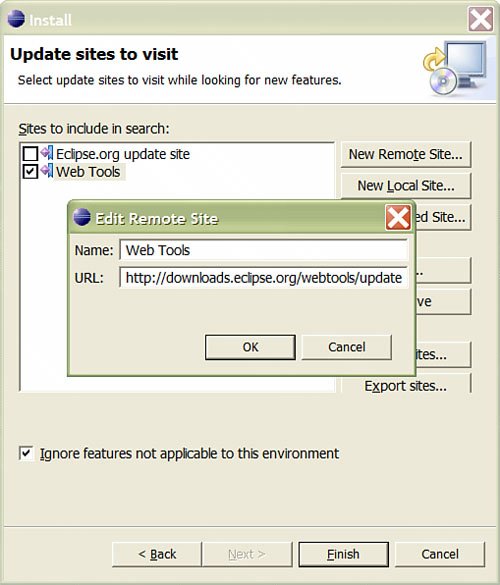Installing the Eclipse Web Tools Platform (WTP) Plug-ins
| If you thought the JDT was a feature-loaded plug-in, you will be impressed by the variety of plug-ins provided as part of the Eclipse Web Tools Platform (WTP) Project. According to the eclipse.org website, "The Eclipse Web Tools Platform (WTP) project extends the Eclipse platform with tools for developing J2EE Web applications. The WTP project includes the following tools: source editors for HTML, JavaScript, CSS, JSP, SQL, XML, DTD, XSD, and WSDL; graphical editors for XSD and WSDL; J2EE project natures, builders, and models and a J2EE navigator; a Web service wizard and explorer, and WS-I Test Tools; and database access and query tools and models." All of this is true and works as advertised. However, there is more than this because the brief description from eclipse.org does not mention support for managing various web/application servers, which we will use to start and stop Tomcat later in this chapter. To install the WTP, follow the instructions provided on the http://www.eclipse.org website to install this plug-in. For example, I was able to install this using the Help, Software Updates, Find and Install menu option. Figure 8.31 shows how I essentially added a new Remote Site for the WTP, http://download.eclipse.org/webtools/updates/, and obtained all the plug-ins from there using this Eclipse software update feature. The process itself is very smooth; however, it is a big download, so it'll take some time to download and install. After the WTP is installed, we will be prompted to restart Eclipse. Also, after installing the WTP, Eclipse might take a bit longer to load at start, presumably because the additional plug-ins we installed require extra time to get verified and loaded. Figure 8.31. Eclipse software update (WTP install shown here). After we have WTP installed successfully, we can select the J2EE perspective from the Window, Open Perspective menu option. The WTP enables us to work with both static (such as HTML) or dynamic (such as EAR files) projects. For example, you will find editors for markup languages such as HTML, XML, as well as editors for JSP and JavaScript; you get the features you have probably come to expect from Eclipse by nowthings such as code assist, templates, and more. However, the WTP is more than just a J2EE content editor. It also provides powerful data and server tools, as we will see later in this chapter, when we leverage these for HSQLDB and Tomcat. |
EAN: 2147483647
Pages: 219
